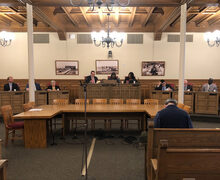Concerns over planned Carrier Dome renovations are similar to worries raised when the venue was built
Brandon Bielinski | Staff Photographer
The Carrier Dome has been a staple of life at Syracuse University since 1980.
The construction of Syracuse University’s signature athletic venue in the late 1970s didn’t come without controversy.
In the years leading up to the Carrier Dome’s opening in 1980, some SU community members expressed displeasure that the university was spending millions to build the stadium. At a University Senate open forum in early 1978, for example, the university’s decision to construct the stadium rather than address academic issues was a “major concern,” according to Daily Orange archives. One person said it was “reprehensible to undertake such a facility.”
Fast forward almost 40 years, and some current campus community members say they have concerns that closely mirror those that were expressed in the late 1970s. This time, the grievances stem from the roughly $205 million in renovations that are planned for the Carrier Dome.
Tens of thousands will pack the Dome on Wednesday when the SU men’s basketball team takes on Duke in what will perhaps be the most prominent event to be held at the Dome this academic year. The stadium has become a staple at the university since its original construction, to a large extent because of important men’s basketball games that frequently set on-campus records for crowd sizes.
But the Dome’s infrastructure is deteriorating. In interviews with community members across campus earlier this academic year, most said they believe something should be done to improve the Dome. But many questioned whether it was necessary for SU to spend as much as it plans to on the renovations, arguing that the university should be funneling more resources into academics.
“The ($205 million) it will cost to renovate Carrier Dome makes a lot of people unhappy,” said Albrecht Diem, an associate professor of history, in a fall interview. “It probably is necessary, but there is, among a lot of faculty, very limited empathy with campus athletics.”
The same could have been said in the late 1970s, when the Dome was merely a conceptual idea and construction was being planned. In 1978 and 1979, at several open forums and city meetings regarding the Dome, community members repeatedly voiced concerns about the Dome construction, often saying they felt it wasn’t the best way to allocate the university’s funds.

Daily Orange File Photo
In the spring of 1979, a University Senate report called for the Dome to not “encroach on the traditional academic … activities of the University, either financially or environmentally.”
“Faculty and students are especially anxious that the new dome not drain money from the traditional university budget,” the report stated.
The then-Senate’s administrative operations committee chair Marvin Druger said in March of the following year that faculty members were concerned that academics at the university were being neglected, possibly in favor of athletics.
“These concerns are the lack of recognition and support of good teaching, overcrowding in classrooms, lack of proper classroom equipment, lack of sufficient study areas, and a need for the improvement of classroom maintenance,” Druger said, according to Daily Orange archives.
At the present-day university, many faculty members are again eager for an increased allocation of resources on those types of academic focal points.
Bruce Carter, chair of the University Senate’s Committee on Budget and Fiscal Affairs, said in an October interview that it’s worth asking whether the campus infrastructure projects such as the Carrier Dome are necessary uses of resources, adding that SU isn’t “rolling in cash.”
Thomas Perreault, a professor of geography, said in an October interview that he likes the idea of renovating the Dome and improving the physical appearance of the campus as a whole in theory, but he added that he doesn’t see those things as the core mission of a university.
He would rather see money spent on campus laboratories and classrooms as well as on improved faculty and staff salaries, which faculty say have leveled off. Perreault also pointed to the buyout of 254 university employees in 2015, which he said he saw as an indication that SU was facing budget constraints.

Daily Orange File Photo
“Do we have $250 million to spend on infrastructure?” Perreault said, referring to the approximate combined cost of renovations to the Dome and Archbold Gymnasium. “And if we do, then why are we pushing staff out the door in the name of fiscal discipline? That to me is the biggest issue that I have.”
Philip Arnold, an associate professor of religion and chair of that department, said he’d prefer to see the university prioritize instruction and academics rather than infrastructure projects and the beautification of the university.
He said faculty want more inclusion and more discussion from university leadership when it comes to making decisions regarding spending, adding that he doesn’t understand where the $205 million budgeted for renovating the Dome is coming from.
“I like athletics,” Arnold said, “but it’s a financial burden on the university.”
Published on February 20, 2017 at 10:08 pm
Contact Michael: mdburk01@syr.edu





